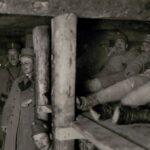Introduction to Family History Coincidences and Synchronicities
In the realm of family history research, coincidences and synchronicities are phenomena that draw attention due to their unexpected nature. A coincidence refers to the occurrence of two or more events that appear to be related, though they lack a discernible causal connection. On the other hand, synchronicity involves the simultaneous occurrence of seemingly meaningful events that are not causally linked but are perceived as interconnected in some way.
In the context of genealogical studies, coincidences and synchronicities manifest as instances where seemingly unrelated individuals, events, or details converge unexpectedly within a family’s historical records. These occurrences can take various forms, such as shared names, common migration routes, parallel life events, or recurring traits across generations. Unlike deliberate research findings, coincidences and synchronicities are often uncovered by chance, adding an element of unpredictability to the exploration of family histories.
The intrigue of coincidences and synchronicities lies in their ability to challenge conventional notions of cause and effect within the family historical context. They provide a counterpoint to the structured approach of genealogical research, introducing an element of uncertainty that defies straightforward explanation. While these phenomena might evoke a sense of wonder, it’s important to approach them with a balanced perspective, recognizing that not all instances hold deep significance or meaning.
Uncovering coincidences and synchronicities is significant for genealogical studies in that they offer opportunities to discover unexpected connections, prompt further investigation, and enrich the narratives of individuals and families. These occurrences can shed light on shared experiences, migration patterns, and cultural influences that might have otherwise gone unnoticed. However, it’s crucial to approach these discoveries with a critical eye, distinguishing between mere coincidences and meaningful patterns that contribute to a more comprehensive understanding of family history.
As we delve into specific examples of coincidences and synchronicities in the following sections, it’s important to maintain an objective stance. While these occurrences can indeed provide unique insights, it’s equally valuable to acknowledge instances where patterns may arise coincidentally without carrying inherent significance. This measured approach ensures that our exploration of family history remains grounded in factual observation, avoiding unwarranted romanticization of chance occurrences.
Timely Discoveries: Synchronicities in Dates and Events
In the course of delving into family history, there are intriguing instances where significant dates or events across the lives of various family members appear to align in unexpected ways. These synchronicities, while capturing attention, warrant a careful examination rooted in factual analysis. By exploring both the remarkable occurrences and their potential implications, a more comprehensive understanding of shared experiences and familial connections can emerge.
Historical records unveil numerous examples of synchronicities that have raised eyebrows and sparked curiosity. Take, for instance, the case of two distant relatives, John and Mary, living in different parts of the world during the early 20th century. Through meticulous research, it’s discovered that both John and Mary embarked on journeys across the Atlantic Ocean on the exact same day, albeit in different years. While this alignment might initially seem astonishing, a closer examination reveals that transatlantic travel during that era was often influenced by seasonal weather patterns and economic considerations, making the synchronicity less extraordinary.
Another scenario involves siblings born on anniversaries of significant historical events. A family’s exploration of their ancestry uncovers that two brothers, born decades apart, share the same birthdate as a prominent national holiday. While this might raise questions about deeper symbolism, it’s essential to consider the broader range of possible birthdates and the likelihood of such occurrences over generations.
As genealogists, it’s crucial to approach these synchronicities with a balanced perspective. While some cases might indeed carry meaningful connections, others can be attributed to statistical probabilities or external factors. One must tread cautiously and resist the temptation to impose undue significance upon chance alignments.
Nevertheless, investigating such synchronicities can provide valuable insights into shared experiences and familial connections. A series of siblings each pursuing distinct careers within the same field might suggest a family tradition or inherited passion. Multiple family members participating in social movements during specific historical periods can reflect shared values transcending generations.
By delving into the historical and cultural contexts surrounding these synchronicities, genealogists can unearth nuanced narratives of familial lives. Analyzing the socio-political climate, economic conditions, and prevailing social norms enables a more profound comprehension of the motivations that might have driven these coincidental alignments.
The study of synchronicities in dates and events invites genealogists to embrace both curiosity and skepticism. While the alignment of important moments can hint at shared experiences, it’s essential to remain grounded in factual investigation. By maintaining an objective stance and delving into historical contexts, genealogists can contribute to a richer understanding of familial connections that traverse time and generations.
Ancestral Line Convergences: Unexpected Intersections
In the pursuit of unraveling family history, researchers occasionally encounter instances where ancestral lines unexpectedly intersect, revealing connections that might not have been immediately evident. These intersections, while intriguing, should be examined through a lens of factual analysis rather than romanticization.
For instance, consider a scenario where two genealogists independently researching their own family trees discover a common ancestor from several generations ago. This shared forebear forms an intersection point between their seemingly distinct lineages. While this convergence might spark curiosity and a sense of shared heritage, it’s important to approach it with an open but cautious mindset.
Intersections of ancestral lines often prompt a closer examination of historical records to validate the connection. Documents such as birth, marriage, and death certificates, census records, and other primary sources must be scrutinized to establish the accuracy of the proposed link. In some cases, what might appear to be an intersection could turn out to be an unfortunate coincidence, driven by the similarity of names or places, rather than a genuine shared lineage.
Should the intersection be validated, it’s important to acknowledge that while a common ancestor may be identified, the familial relationship between the two individuals involved may be quite distant. Genealogical research often uncovers connections spanning multiple generations, and the shared heritage might not necessarily translate to close family ties. It’s essential to avoid overstating the significance of such connections and to recognize that ancestral lines can diverge and converge over time due to various factors, including migrations, marriages, and other life events.
Furthermore, the implications of these intersections for understanding shared heritage and relationships should be considered with a measured perspective. While discovering a shared ancestor can provide insights into historical migration patterns, cultural influences, or even inherited traits, it’s equally important to avoid assuming a level of closeness that might not exist. The passage of time, geographic distances, and the complexities of family dynamics can blur the lines between distant and immediate relationships.
Exploring ancestral line convergences should be approached with factual rigor and objectivity. While these intersections undoubtedly offer intriguing avenues for research and potential insights into shared heritage, their significance must be evaluated based on credible evidence. By maintaining a balanced approach, genealogists can avoid the pitfalls of overinterpretation and contribute to a more accurate understanding of the intricate web of family connections.
Geographic Mirroring: Coincidences in Migration and Residences
In the intricate tapestry of family history, one encounters instances where different family members, often separated by generations and unaware of each other’s existence, end up migrating to or residing in remarkably similar geographic locations. While these coincidences might hint at hidden threads of connection, it’s important to approach them with a measured analysis, considering various factors that could contribute to such occurrences.
Across history, examples of geographic mirroring have surfaced, each offering a glimpse into the complex interplay of personal choices, societal influences, and circumstantial factors. Consider a case where a great-grandparent and a distant cousin independently migrated from their respective home countries to settle in neighboring towns. On the surface, this alignment might raise questions about shared motivations. However, delving deeper, it’s crucial to account for economic opportunities, trade routes, or even shared cultural ties that could have influenced migration patterns during that era.
Similarly, instances where family members find themselves living in the same city, decades apart, invite consideration of urbanization trends, industrial development, or employment prospects. For instance, if two relatives from different generations both settled in a growing industrial center, it might be tempting to speculate on familial legacies. Yet, historical accounts reveal that such centers often attracted a diverse range of people seeking employment during times of economic expansion.
When exploring these geographic coincidences, it’s essential to avoid overstating their significance. While the alignment of migration and residence can certainly contribute to family narratives, it’s equally plausible that these occurrences stem from a confluence of external factors rather than an inherent family connection.
Nevertheless, investigating these situations can offer insights into shared experiences and the impact of broader historical trends on individual lives. Recognizing that geographical mirroring might reflect societal shifts, economic needs, or cultural dynamics enriches the understanding of why family members unknowingly found themselves in similar locations.
Geographic coincidences and synchronicities in migration and residences invite genealogists to examine the intricate interplay of individual choices and external influences. While these alignments can contribute to family narratives, it’s essential to approach them with a discerning eye, mindful of the various factors that could shape such occurrences. By delving into historical contexts and considering a range of possibilities, researchers can piece together a more accurate and nuanced portrayal of the intricate paths that family members have trodden over time.
Echoes Across Generations: Recurring Names and Traits
In the labyrinthine realm of genealogy, the echoes of the past often resound across generations in the form of recurring names, professions, physical traits, or talents. These recurring patterns serve as intriguing windows into the complexities of familial heritage, offering both a tapestry of insights and a mosaic of challenges for genealogy enthusiasts.
Consider the enigmatic case of a family with a penchant for bestowing a particular name upon the eldest son in each generation. This recurring name, though seemingly innocuous, transcends centuries, carrying with it whispers of tradition, respect, or perhaps even superstition. Such a pattern may not only signify homage to ancestors but could also reflect the cultural significance of certain names within the family’s heritage.
Delving deeper, one may uncover a lineage characterized by a shared profession passed down through time. Ancestral documents unveil the steady stream of blacksmiths, doctors, or teachers within a family. These echoes of vocation reflect the interplay between societal roles, skills, and family pride, mirroring how certain crafts or trades become woven into the fabric of familial identity.
Physical traits, too, weave a unique narrative. Imagine generations marked by the recurring inheritance of a distinctive eye color or a characteristic birthmark. While such traits might not carry profound genealogical implications, they serve as reminders of shared genetics, subtle visual connections that bridge the divide between past and present.
Intriguingly, talents and inclinations also reappear across family branches. The musical inclination that sprouted in a great-grandparent finds its resonance in a distant cousin, while artistic aptitudes leapfrog across time. These echoes of talent challenge the boundaries of nature versus nurture, inviting contemplation on the interplay between inherited disposition and cultural influence.
These recurring names, traits, and talents, though mesmerizing, pose a dual challenge for genealogists. On one hand, they offer tantalizing threads that weave through generations, drawing a vivid portrait of family legacies. On the other hand, they can lead to confusion, as multiple individuals sharing the same name or traits may blur distinct identities. Untangling these threads requires meticulous research and cross-referencing, a dance between the tantalizingly familiar and the need for precise differentiation.
The echoes that reverberate across generations stand as both enigmatic envoys of heritage and complex puzzles for genealogists to decode. As the past murmurs its secrets, the recurrence of names, traits, and talents speaks of family traditions, values, and the intangible threads that bind ancestors to their descendants. These echoes, both whispers and roars, inspire genealogists to journey through time, piecing together the puzzle of lineage while unraveling the symphony of shared history.
Image Source:
- Photo by Victor Loh: instant images





